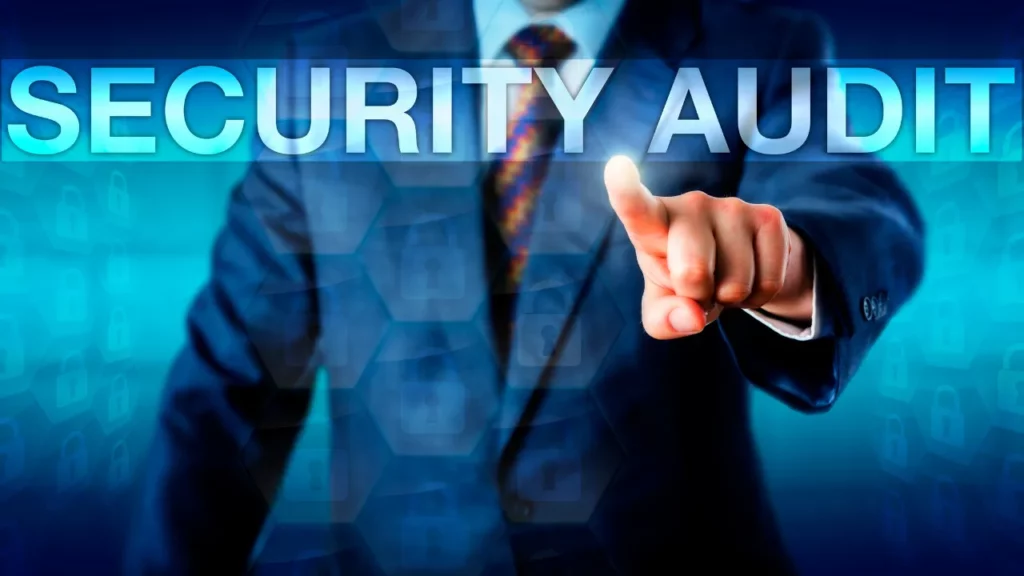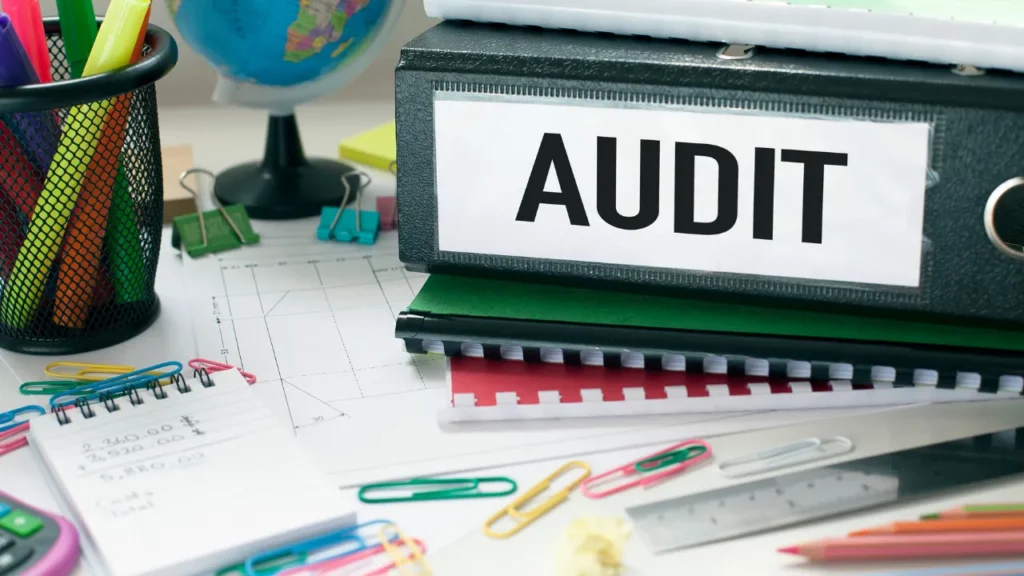Physical Address
304 North Cardinal St.
Dorchester Center, MA 02124
Physical Address
304 North Cardinal St.
Dorchester Center, MA 02124

In today’s digital age, security breaches are becoming a common occurrence. To prevent such incidents, businesses and organizations perform security audits to identify vulnerabilities and take necessary measures to protect their sensitive information.
A security audit is a comprehensive evaluation of an organization’s security posture, including its policies, procedures, and controls. In this blog post, we will dive deep into the concept of a security audit and its importance in today’s world.
We will also discuss how it functions, differentiate it from penetration testing and vulnerability assessments, and cover the key components of a comprehensive security audit checklist for 2024.
Additionally, we will explore the necessity of regular audits for organizations and how they can maintain security standards throughout the year. Lastly, we’ll debunk some common myths around security audits and answer some frequently asked questions about them.

A security audit involves evaluating an organization’s adherence to security policies and industry standards. It assesses the effectiveness of the organization’s security controls and helps identify security gaps and vulnerabilities in its IT infrastructure.
Regularly conducting security audits is crucial for maintaining a strong security posture and mitigating security risks. By identifying potential threats and vulnerabilities, a security audit plays a significant role in enhancing an organization’s security posture.
It helps protect against unauthorized access, data breaches, and potential attacks from hackers. Understanding the concept of a security audit is the first step toward ensuring the organization’s information technology systems’ functionality and compliance with industry regulations.
In today’s digital age, with the increasing number of cyber-attacks, security audits play a crucial role in protecting sensitive information. These audits help organizations comply with legal and regulatory requirements such as HIPAA or PCI DSS.
By conducting regular audits, organizations can ensure that their security measures are up to date and effective in mitigating emerging security threats.
Furthermore, security audits provide stakeholders with confidence in the organization’s security posture and help proactively address potential breaches by identifying vulnerabilities.
In the face of constantly evolving hackers and unauthorized access attempts, security audits have become the first step in maintaining an organization’s security posture.
A security audit functions by evaluating an organization’s security controls, policies, and procedures. The audit team thoroughly examines IT systems and documentation, assessing access controls, passwords, encryption, and physical security measures.
Through vulnerability scans and penetration testing, potential weaknesses are identified to develop a remediation plan and improve the overall security program.
When conducting a security audit, the main objectives are to assess the organization’s security posture and identify vulnerabilities, weaknesses, and non-compliance with security policies.
The audit aims to ensure the adequacy and effectiveness of security controls and measures. By identifying potential threats and risks to sensitive data and information systems, organizations can enhance their security program and mitigate security risks.
Overall, the primary objective of a security audit is to evaluate the organization’s security measures and provide recommendations for improvement.
Read More: Security Assessments 101: Conducting Effective Security Assessments in 2024
While audits provide a comprehensive evaluation of an organization’s security posture, penetration testing and vulnerability assessments offer more targeted approaches. A security audit assesses the overall security posture by evaluating controls, policies, and procedures.
On the other hand, penetration testing simulates real-world attacks to identify vulnerabilities and exploitable weaknesses. Vulnerability assessments focus on identifying and prioritizing vulnerabilities in systems and networks.
Together, these activities help organizations strengthen their security defenses against potential threats. By distinguishing between these three types of assessments, organizations can ensure a holistic approach to safeguarding their information and systems.

To conduct a comprehensive security audit, the audit team evaluates the organization’s information security policies and documentation. They assess the implementation and effectiveness of security controls, including access controls, firewalls, antivirus software, and other measures.
A risk assessment is conducted to identify and prioritize potential security threats. Additionally, the audit includes an examination of physical security measures and the organization’s response to security events.
By assessing these key components, organizations can strengthen their security posture, protect against unauthorized access, and proactively mitigate the risk of data breaches.
When conducting security audits, it is essential to carefully select the criteria used for evaluation. These criteria are based on industry standards, regulatory requirements, and internal policies.
Auditors typically focus on areas such as data security, network infrastructure, and employee training. The chosen criteria should be relevant, measurable, and aligned with the organization’s security objectives.
By using appropriate criteria, auditors can effectively evaluate the organization’s compliance and adherence to security standards. This ensures that the organization’s security posture is strong and protected against potential threats.
Assessing staff training is a crucial aspect of a security audit. Auditors gauge the effectiveness of training programs in raising awareness about security risks and best practices. The evaluation encompasses analyzing the frequency, relevance, and comprehensiveness of security training.
Additionally, auditors assess whether employees comprehend their responsibilities and adhere to established security policies. This evaluation aids in identifying areas where additional training or awareness initiatives may be necessary.
By evaluating staff training, organizations can enhance their security posture and mitigate the risk of unauthorized access and data breaches.
When it comes to a security audit, it’s important to assess how an organization responds to security events and incidents. Auditors evaluate the incident response plan and documentation to ensure they are effective.
They also look at the procedures for detecting, reporting, and containing incidents. Another crucial aspect of the audit is examining how the organization learns from security events and implements improvements.
All of these assessments help enhance the incident response capabilities of the organization, allowing them to better protect against unauthorized access and potential data breaches.
During a security audit, vulnerabilities come to light through various means, such as vulnerability scanning and penetration testing. Vulnerability scans systematically identify weaknesses in systems, networks, and applications.
Conversely, penetration testing mimics real-world attacks to pinpoint exploitable vulnerabilities. The auditor’s role is then to assess the severity and potential impact of these identified vulnerabilities.
This enables organizations to prioritize their remediation efforts and bolster their security defenses. By taking this next step, organizations can proactively safeguard themselves against unauthorized access and potential data breaches.
After a security audit, it is crucial to address the vulnerabilities identified and enhance cybersecurity. Based on the audit findings, organizations should develop and implement security controls to protect against unauthorized access and data breaches.
Regularly updating security documentation ensures accuracy and compliance with regulations such as ISO and the Health Insurance Portability and Accountability Act.
Conducting regular risk assessments helps identify new security threats and allows for proactive measures. It is also important to ensure stakeholders are aware of and trained on security policies and procedures. By implementing these protective measures, organizations can strengthen their security posture.

Security audits play a crucial role in organizations by identifying and addressing security gaps in their IT infrastructure. These audits assess the adequacy of security measures and controls, helping to prevent and mitigate the risk of security breaches and data loss.
Additionally, security audits ensure compliance with industry standards and regulations, such as ISO and the Health Insurance Portability and Accountability Act (HIPAA).
Conducting regular security audits also demonstrates an organization’s commitment to protecting sensitive information and improving its overall security posture. By staying proactive and conducting thorough audits, organizations can stay one step ahead of potential hackers and unauthorized access attempts.
To perform an effective security audit, it is important to define the objectives of the audit to guide the process. This ensures that the audit focuses on the specific areas that need to be evaluated.
Next, a thorough review of information systems and security controls should be conducted to assess their effectiveness in protecting the organization’s data.
This involves evaluating the organization’s security posture and identifying potential vulnerabilities. The audit findings should be carefully documented, and recommendations for remediation should be developed. Finally, the audit findings and recommendations should be presented to management and stakeholders for further action.
When it comes to determining the frequency of security audits, there are several factors to consider. First and foremost, industry standards and regulations play a crucial role in setting the benchmark for audit frequency. These guidelines outline the minimum requirements organizations should adhere to.
Additionally, assessing the organization’s risk profile and potential threats is essential. This involves evaluating the sensitivity of the data being handled, the level of potential unauthorized access, and the organization’s security posture.
By understanding these factors, organizations can determine how frequently audits should be conducted to ensure their security measures are robust enough to mitigate any risks.
It’s important to note that regular audits should be conducted to keep up with the ever-evolving landscape of security risks. As technology and business operations change, new vulnerabilities may arise. Therefore, organizations need to stay proactive by conducting audits at regular intervals to identify any weaknesses and address them promptly.
In certain circumstances, changes in technology or business operations may prompt additional audits. For example, if an organization adopts a new system or implements significant changes to its infrastructure, it may warrant an extra audit to ensure the new components are secure and functioning properly.
To provide an objective assessment of an organization’s security measures, it’s advisable to engage an independent auditor. By doing so, organizations can benefit from unbiased evaluations and recommendations that can further enhance their security practices.
Determining the frequency of security audits requires careful consideration of industry standards, risk profiles, evolving security risks, technological changes, and the expertise of independent auditors.
By incorporating these factors into the decision-making process, organizations can create a comprehensive audit schedule that helps maintain their security standards and keeps them protected from potential threats.

Regular audits play a crucial role in maintaining security standards within organizations. By conducting these audits on a regular basis, companies can ensure ongoing compliance with security policies and standards.
Additionally, audits help identify and address new vulnerabilities and emerging threats, allowing organizations to stay one step ahead of hackers and unauthorized access attempts.
Moreover, audits provide valuable insight into the effectiveness of security controls and measures, enabling organizations to continuously improve their security posture.
Ultimately, regular audits reinforce a culture of accountability and help organizations protect sensitive data from potential data breaches.
To create an effective 2024 security audit checklist, organizations should assess information security policies and procedures, conduct vulnerability assessments and penetration testing, review access controls and authentication mechanisms, evaluate physical security measures, and assess incident response protocols.
As technology advances, so do the tactics of hackers and cybercriminals. In 2024, it’s crucial to keep a watchful eye on new malware and hacking techniques that could compromise your organization’s security.
Additionally, wireless networks pose potential security risks that must be diligently monitored. Stay updated on emerging trends in social engineering and phishing attacks, as they continue to evolve.
Furthermore, assess the security posture of cloud-based systems and services, and be aware of the ever-changing landscape of regulatory requirements. By staying vigilant and proactive, you can mitigate the impact of these emerging security threats.
Audits are not just necessary for large organizations. All organizations, regardless of their size, can benefit from regular security audits. It is a misconception that audits are a one-time event. In fact, regular audits are essential for maintaining security standards.
Another common myth is that audits are solely focused on technology. However, audits assess not only technology but also people and processes. By debunking these misconceptions, organizations can understand the true value of security audits in enhancing their overall security posture.
The evolution of security audit practices has seen a shift from compliance-driven audits to risk-based audits. Auditors now incorporate comprehensive vulnerability scans and penetration testing, while placing increased emphasis on data security and protection of sensitive information.
They also consider the organization’s security program and culture, making audits more proactive in identifying and addressing security risks.
In conclusion, a comprehensive security audit is crucial for organizations to identify vulnerabilities, assess staff training, evaluate responses to security events, and implement protective measures. As technology evolves, so do security threats, which is why regular audits are necessary to maintain security standards.
The 2024 security audit checklist should include criteria selection, staff training evaluation, vulnerability identification, and protection implementation. It is important to stay updated on emerging security threats and debunk common misconceptions about security audits.
By conducting thorough security audits and taking proactive measures, organizations can ensure the safety and integrity of their digital systems and data. Stay one step ahead of potential security breaches by prioritizing regular security audits and staying informed about the latest practices in the field.